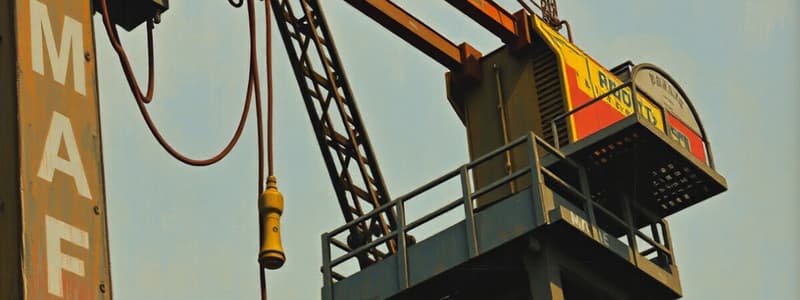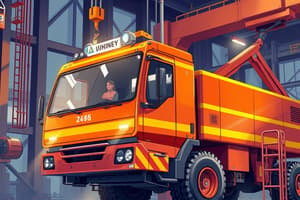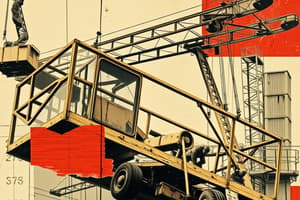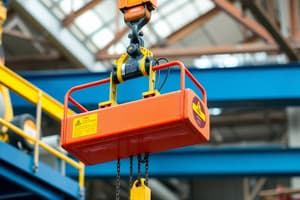Podcast
Questions and Answers
What is the primary function of Approved Codes of Practice (ACoPs)?
What is the primary function of Approved Codes of Practice (ACoPs)?
- To serve as promotional material for trade associations
- To establish penalties for safety violations
- To provide financial guidance for businesses
- To detail how to comply with legal requirements (correct)
Who typically issues Approved Codes of Practice (ACoPs)?
Who typically issues Approved Codes of Practice (ACoPs)?
- Private companies
- Trade associations exclusively
- Industry professionals without oversight
- Relevant authorities with government minister consent (correct)
What happens if someone fails to comply with the provisions of an ACoP?
What happens if someone fails to comply with the provisions of an ACoP?
- They are fined a standard monetary amount
- It may be used as evidence in criminal proceedings (correct)
- The employer must retrain all staff members
- It is considered a criminal offense automatically
Which of the following is NOT a type of Code of Practice listed?
Which of the following is NOT a type of Code of Practice listed?
Who is considered a duty holder in the context of lifting equipment?
Who is considered a duty holder in the context of lifting equipment?
What is the consequence of contravening the advice in a Code of Practice?
What is the consequence of contravening the advice in a Code of Practice?
What is the significance of ACoPs beyond guidance?
What is the significance of ACoPs beyond guidance?
Which type of Code of Practice is directly aimed at compliance with health and safety regulations?
Which type of Code of Practice is directly aimed at compliance with health and safety regulations?
What is one of the financial consequences for employers who fail to manage employee health and safety?
What is one of the financial consequences for employers who fail to manage employee health and safety?
Which of the following is a consequence of unsafe working conditions?
Which of the following is a consequence of unsafe working conditions?
What is the primary health and safety legislation in the USA?
What is the primary health and safety legislation in the USA?
Which of the following statements about legislation and regulations is TRUE?
Which of the following statements about legislation and regulations is TRUE?
What can be a societal consequence of poor health and safety management by an employer?
What can be a societal consequence of poor health and safety management by an employer?
How does the Health and Safety at Work Act contribute to safety management?
How does the Health and Safety at Work Act contribute to safety management?
Which of the following consequences is associated with a decline in production due to poor safety practices?
Which of the following consequences is associated with a decline in production due to poor safety practices?
What is a common misconception about health and safety culture in a company?
What is a common misconception about health and safety culture in a company?
What is one of the responsibilities of employers regarding work equipment?
What is one of the responsibilities of employers regarding work equipment?
Which document outlines the essential safety requirements manufacturers must consider?
Which document outlines the essential safety requirements manufacturers must consider?
What defines a 'Competent Person' in the context of health and safety legislation?
What defines a 'Competent Person' in the context of health and safety legislation?
What is a duty of employers in terms of information for employees?
What is a duty of employers in terms of information for employees?
Which of the following is NOT a responsibility of equipment manufacturers?
Which of the following is NOT a responsibility of equipment manufacturers?
What is the purpose of COPSULE in the context of work equipment legislation?
What is the purpose of COPSULE in the context of work equipment legislation?
Why is it important for a Competent Person to seek specialist advice?
Why is it important for a Competent Person to seek specialist advice?
What must equipment be in order for it to comply with safety standards set by employers?
What must equipment be in order for it to comply with safety standards set by employers?
What is the primary responsibility of a competent person inspecting lifting equipment?
What is the primary responsibility of a competent person inspecting lifting equipment?
What type of inspection is typically performed by the user before using lifting equipment?
What type of inspection is typically performed by the user before using lifting equipment?
Which inspection is also known as the 'frequent inspection'?
Which inspection is also known as the 'frequent inspection'?
What is the purpose of the interim inspection?
What is the purpose of the interim inspection?
Which of the following is NOT a level of inspection described?
Which of the following is NOT a level of inspection described?
What action should a user take if they notice a defect during the pre-use inspection?
What action should a user take if they notice a defect during the pre-use inspection?
What does the term 'Factor of Safety' relate to in the context of lifting equipment?
What does the term 'Factor of Safety' relate to in the context of lifting equipment?
Which statement best describes a thorough examination of lifting equipment?
Which statement best describes a thorough examination of lifting equipment?
What is the primary purpose of a thorough examination of lifting equipment?
What is the primary purpose of a thorough examination of lifting equipment?
Which of the following is NOT a reason for regularly inspecting lifting equipment?
Which of the following is NOT a reason for regularly inspecting lifting equipment?
Which of the following best describes a lifting accessory?
Which of the following best describes a lifting accessory?
What type of equipment is referred to as a lifting appliance?
What type of equipment is referred to as a lifting appliance?
What should be included in the inspection regime for lifting accessories?
What should be included in the inspection regime for lifting accessories?
Why is it important for lifting accessories to be considered in lift planning?
Why is it important for lifting accessories to be considered in lift planning?
Which statement best defines a thorough examination?
Which statement best defines a thorough examination?
What could be a consequence of not conducting regular inspections on lifting equipment?
What could be a consequence of not conducting regular inspections on lifting equipment?
Which of the following is NOT an example of a lifting appliance?
Which of the following is NOT an example of a lifting appliance?
What is implied when a manufacturer places lifting equipment on the market?
What is implied when a manufacturer places lifting equipment on the market?
What document serves as the manufacturer’s confirmation of compliance with applicable legal requirements?
What document serves as the manufacturer’s confirmation of compliance with applicable legal requirements?
Which statement about the manufacturer’s certificate is TRUE?
Which statement about the manufacturer’s certificate is TRUE?
In the absence of a manufacturer, who is deemed to be the manufacturer?
In the absence of a manufacturer, who is deemed to be the manufacturer?
Why is the manufacturer's certificate sometimes referred to as the product's 'birth certificate'?
Why is the manufacturer's certificate sometimes referred to as the product's 'birth certificate'?
What must be retained as part of the lifting equipment records?
What must be retained as part of the lifting equipment records?
Which of these functions is NOT associated with lifting equipment?
Which of these functions is NOT associated with lifting equipment?
Flashcards
Approved Code of Practice (ACoP)
Approved Code of Practice (ACoP)
Detailed guidance on how to meet legal requirements in health and safety regulations, issued by relevant authorities.
Recommended Code of Practice (RCoP)
Recommended Code of Practice (RCoP)
Guidance on best practice that is not legally binding but advises how to meet regulations.
Code of Practice
Code of Practice
Document providing guidance on how to fulfill legal responsibilities in health and safety.
Duty Holder
Duty Holder
Signup and view all the flashcards
Health and Safety Regulations
Health and Safety Regulations
Signup and view all the flashcards
Legal Requirements
Legal Requirements
Signup and view all the flashcards
Contravening A Code
Contravening A Code
Signup and view all the flashcards
Evidence in Court
Evidence in Court
Signup and view all the flashcards
Employer's Health and Safety Obligations
Employer's Health and Safety Obligations
Signup and view all the flashcards
Consequences of Poor Safety
Consequences of Poor Safety
Signup and view all the flashcards
Loss of Output
Loss of Output
Signup and view all the flashcards
Health and Safety Culture
Health and Safety Culture
Signup and view all the flashcards
Legislation
Legislation
Signup and view all the flashcards
Regulations
Regulations
Signup and view all the flashcards
UK Health and Safety Legislation
UK Health and Safety Legislation
Signup and view all the flashcards
Global Lifting Equipment Legislation
Global Lifting Equipment Legislation
Signup and view all the flashcards
Employer's Equipment Duties
Employer's Equipment Duties
Signup and view all the flashcards
Equipment Compliance
Equipment Compliance
Signup and view all the flashcards
Equipment Maintenance
Equipment Maintenance
Signup and view all the flashcards
Equipment Safety Provision
Equipment Safety Provision
Signup and view all the flashcards
Employee Training/Information
Employee Training/Information
Signup and view all the flashcards
Equipment Selection
Equipment Selection
Signup and view all the flashcards
Competent Person
Competent Person
Signup and view all the flashcards
Equipment Manufacturer Responsibilities
Equipment Manufacturer Responsibilities
Signup and view all the flashcards
Thorough Examination
Thorough Examination
Signup and view all the flashcards
Lifting Equipment
Lifting Equipment
Signup and view all the flashcards
Lifting Accessory
Lifting Accessory
Signup and view all the flashcards
Lifting Appliance
Lifting Appliance
Signup and view all the flashcards
Why Inspect Regularly?
Why Inspect Regularly?
Signup and view all the flashcards
Pre-use Inspection
Pre-use Inspection
Signup and view all the flashcards
Interim Inspection
Interim Inspection
Signup and view all the flashcards
Lifting Equipment Competency
Lifting Equipment Competency
Signup and view all the flashcards
Inspection Levels
Inspection Levels
Signup and view all the flashcards
Risk Assessment
Risk Assessment
Signup and view all the flashcards
Inspection Personnel
Inspection Personnel
Signup and view all the flashcards
Equipment Defects
Equipment Defects
Signup and view all the flashcards
Manufacturer of Lifting Equipment
Manufacturer of Lifting Equipment
Signup and view all the flashcards
Manufacturer's Certificate
Manufacturer's Certificate
Signup and view all the flashcards
Working Load Limit (WLL)
Working Load Limit (WLL)
Signup and view all the flashcards
Statement of Conformity
Statement of Conformity
Signup and view all the flashcards
Record of Test
Record of Test
Signup and view all the flashcards
'Birth Certificate' for Lifting Equipment
'Birth Certificate' for Lifting Equipment
Signup and view all the flashcards
Importance of Lifting Equipment Records
Importance of Lifting Equipment Records
Signup and view all the flashcards
Study Notes
Foundation Certificate (FOU) (Global) Workbook
- This course provides essential knowledge for those pursuing Diploma qualifications in lifting equipment.
- A mandatory requirement to complete the Foundation Certificate is necessary before accessing LEEA's Diploma qualifications.
- Core topics include legislation, regulations, standards, best practice, definitions, risk control, materials science, units of measurement, basic machines, manufacturer's verification, lifting equipment rating, and types of lifting equipment.
- Successful completion enables students to identify appropriate standards and best practices for specific lifting equipment use.
- Students will also be able to identify different lifting equipment, describe materials and methods of manufacture, and how manufacturers verify the equipment and defects.
Legislation and Regulations
- Legislation and regulations govern the lifting equipment industry, establishing rules for decision-making, agreements, and frameworks.
- Employers bear primary responsibility for health and safety, while employees also have legal responsibilities for their actions.
- Employers have a moral duty to ensure appropriate working conditions are provided.
- Consequences for failing to manage health and safety include unsafe working conditions, reduced output, loss of sales, lower morale and motivation , negative PR, high financial costs, fines, damages, legal and insurance costs.
Standards
- Standards are published specifications providing a common language and technical criteria for materials, products, methods, and services, promoting reliability and effectiveness.
- Standards are developed by committees with subject-matter experts and include discussion, draft creation, comments, and publication phases.
- Standards, like ISO and BSI standards, are used globally.
- A quasi-legal standing often accompanies widely recognized standards.
Codes of Practice
- Codes of Practice (ACoPs and RCoPs) provide detailed guidance on fulfilling legal requirements, often accompanying health and safety legislation without specifying how employers should comply with regulations.
- ACoPs are usually issued by governing authorities after consulting with stakeholders, and these are significant beyond simple guidance.
- ACoPs often clarify their status, often stating that failure to comply can still be used as evidence in legal proceedings for non-compliance.
Duty Holder
- The duty holder is the individual responsible for the lifting equipment they use or own.
- Modern legislation puts responsibility on duty holders, employers, and supply-chain members for safe equipment usage.
- Duty holders are not always employers but may be building owners, equipment managers, or hiring companies.
Inspection
- Inspections assess equipment fitness for service.
- Three key inspection levels exist: pre-use, interim, and thorough, each with varying frequencies and detail depending on the equipment and risk assessment.
Lifting Equipment
- Lifting Equipment describes lifting accessories and appliances, including any gear used to connect a load to the main lifting appliance.
- Lifting Accessories are often referred to as lifting gear, lifting tackle or rigging equipment.
- Lifting Appliances include cranes, hoists, and jacks.
Manufacturers' Certificates
- Manufacturers issue certificates, records of tests, or statements of conformity confirming compliance with relevant standards.
- These documents, known as "birth certificates," are essential records for lifting equipment.
Studying That Suits You
Use AI to generate personalized quizzes and flashcards to suit your learning preferences.




